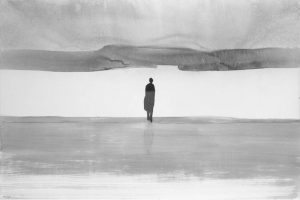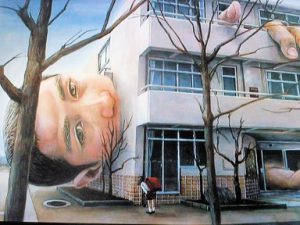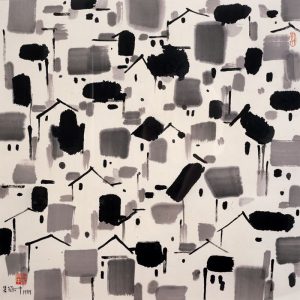
Fragmentos de La montaña del alma, Ink Painting, Gao Xingjian
-WHY
Autism is the fastest-growing developmental disability and about 1 percent of the world population has autism spectrum disorder. Timely and effective treatment can allow them to adapt to the normal life while a large number of autistic children attend mainstream schools where the built environment is unbearable and confusing to them. People with ASD show signs of less challenging behavior and enhanced well being if they live and learn in an environment that promotes a sense of inclusion and considers their specific needs. However the aim of education is not only protect them from been hurt but also help them get used to the world. The traditional care center as an isolated utopia is not enough for social demands and the treatment of autism.
-Thesis Statement
About 1 in 68 children has been identified with autism spectrum disorder (ASD). Timely and effective treatment can help them adapted to the normal life. The project aims to create a prototype which can be plugged-in or extruded from regular kindergarten and primary school buildings.

Prisoner, Tetsuya Ishida, 1999
-WHAT-Description of contexts and key ideas driving the thesis
1) Create safe and comfortable environment.
Autistic kids have trouble dealing with space cause they rely on two dimension visual prospection. It’s difficult for them to related location with shape and texture. Design spaces with high identification for different activities would be helpful.
Because of sensory sensitivities, Autistic children suffer from overloading information in many public environment which always crash them down. A comfort space without noise, bright color and sharp corner will form an ordered and caring environment where children and pupils feel safe and teachers can excel in their roles.

How people with autism see the world: Gaze of those with the condition bypasses faces to see details such as color and contrast
2) Improve children behavior with the spatial design.
Some individuals with autism struggle understanding their body in relation to itself, the greater environment, and planning their movements through it. Architecture design should base on the treatment or training method of autism. For example, The lay-out of general school, both within and between spaces, usually leaves much to be desired, something which causes disorientation on the part of students on the spectrum, which is detrimental to their education and general development. The circulation they need should match the routine of autistic children activity to enhance well being.
3) Relationship between traditional school.
The project will be a prototype which can be plugged in/added on/attached to/extruded from existing school building.
Autistic children should grow up together with other children. Specific space for autistic kids should be part of every school. It’s better for autistic children learning than a iron tower in sub-urban area and it’s good for others understand and accept people with autism at the same time. What’s more, it’s more efficient, applicable and economical in construction, which would help more people.

Home of Man, 1999, ink and color on rice paper, 69 x 69 cm, Shanghai Art Museum. Wu Guanzhong
-Description of Project Intended to Test the Thesis Statement
Children with autism have difficulties with social interaction and anxiety and may suffer with sensory processing disorder which includes being sensitive to touch, and hearing or seeing noises and lights more intensely.
-Methodological Processes/ Outline of Research/ Design Experiments.
The progress is divided into two parts: psychological part and social part.
The psychological part is based on research about autistic children’s behavior and psychotherapy, find out difficulties they are facing and psychological intervention used to help with, translate the methods to architectural language to provide autism friendly architecture. This part is more about interior design like the shape of classroom and corridor, color, texture of materials even furniture design.
The social part is to mapping and typology the existing school buildings, analysis massing and circulation, create some potential type of the new space physically. Ultimately, combine the results of two parts and evolve a typology.
-Annotated Bibliography/ Precedents
Book:
The gift of therapy : an open letter to a new generation of therapists and their patients
Irvin D. Yalom, New York : HarperCollins, 2002
Designing for autism spectrum disorders, Kristi Gaines, New York, NY : Routledge 2016
Designing to heal, Jenny Donovan, Collingwood, 2013
Autism spectrum disorders : phenotypes, mechanisms and treatments, Karger. Basel, Switzerland
Article:
Autism-friendly architecture from the outside in and the inside out: an explorative study based on autobiographies of autistic people, Marijke Kinnaer1 • Stijn Baumers1 • Ann Heylighen
Design considerations for the autism spectrum disorder-friendly Key Stage 1 classroom, KEITH MCALLISTER and BARRY MAGUIRE
Designing environments for children and adults on the autism spectrum Christopher Beaver, London
ARCHITECTURE FOR AUTISM: Autism ASPECTSS™ in School Design Magda Mostafa, International Journal of Architectural Research 143
Website:
http://www.autism.org.uk/
http://www.autism-architects.com/
http://www.architectuur-voor-autisme.org/?lang=en
|
One Comment